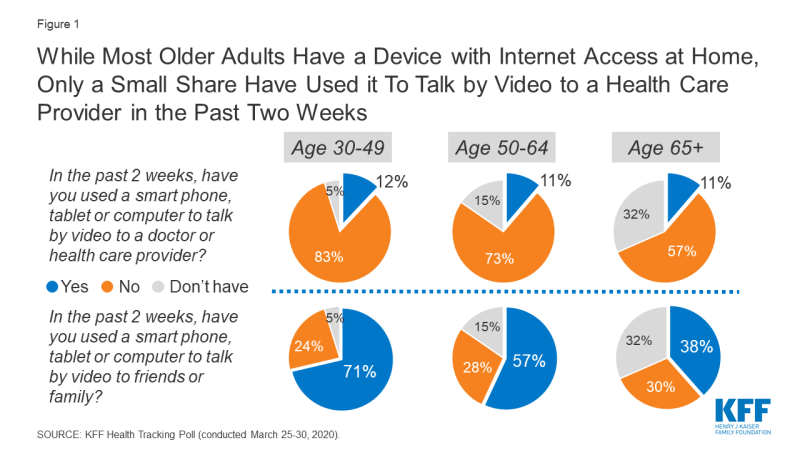Possibilities and Limits of Telehealth for Older Adults During the COVID-19 Emergency
Juliette Cubanski
Published:
As the coronavirus pandemic sweeps across the U.S., millions of people around the country are living under directives to stay home to avoid risking exposure to the virus or infecting others if they are ill. To address the ongoing need for medical treatment during this time of physical distancing, there has been a rapid expansion in the availability of many health care services by telehealth, which allows physicians and other health care providers to furnish services to their patients at remote locations, including in their homes. In particular, Medicare has lifted several restrictions on who can receive telehealth and the types of services they can receive via telehealth during the COVID-19 public health emergency. This is especially important for people 65 and older, since virtually all are at greater risk of becoming seriously ill if they are infected with the new coronavirus that causes COVID-19.
But findings from the latest KFF Health Tracking Poll suggest telehealth might have limited reach among older adults, at least in the near term. While nearly seven in 10 adults 65 and older (68%) say they have a computer, smart phone or tablet with internet access at home (compared to virtually all adults ages 30-49 and 85% of adults ages 50-64), only 11% of people ages 65 and older say they have used a device to talk by video to a doctor or health care provider in the past two weeks (Figure 1). This is about the same percentage as among younger adults (12% of those ages 30-49 and 11% of those ages 50-64).

Figure 1: While Most Older Adults Have a Device with Internet Access at Home, Only a Small Share Have Used it To Talk by Video to a Health Care Provider in the Past Two Weeks
Of course, these low rates could reflect a lack of need, not lack of interest. But a more telling sign about comfort level with using video technology is reflected in the share of people who used an internet-connected device to talk by video with family and friends in the past two weeks, which drops from 71% of people ages 30-49 to 57% of people ages 50-64 and 38% of people ages 65 and older.
While it might not be too surprising that a relatively small share of people ages 65 and older say they’ve used an internet-connected device for video communication with a health care provider in recent weeks, this finding might put some realistic bounds on expectations for use of telehealth by people with Medicare during the COVID-19 emergency. At the same time, we might expect this share to increase somewhat as more patients learn about the option to seek medical care from their providers via telehealth. Family members might also be encouraging their older relatives to use telehealth in order to safely receive care they may need from their own homes.
The good news in these poll findings is that most older adults have an internet-connected device in their homes that they could use to take advantage of the expansion of health care services via telehealth under Medicare. And there are new, albeit limited, allowances for some evaluation and management services to be provided to patients via audio-only telephone, which could be helpful for the 32% of people 65+ who don’t have an internet-connected device at home. The provision of these services during the COVID-19 emergency may also pave the way for more widespread adoption of telehealth moving forward. Although a majority of people 65 and older have not used telehealth services in recent weeks, this could change moving forward as stay-at-home orders are extended. For older adults who are able to use telehealth, getting needed care while avoiding exposure to others who may be ill is an important benefit.
